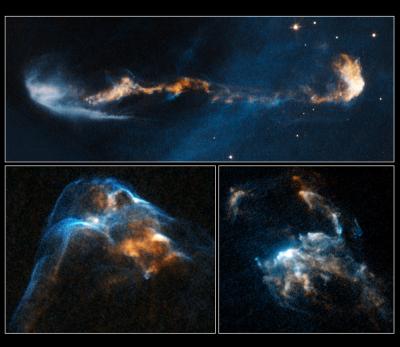Hubble movies provide unprecedented view of supersonic jets from young stars
August 31, 2011

The glowing, clumpy streams of material shown in these NASA/ESA Hubble Space Telescope images are the signposts of star birth (credit: NASA, ESA, and P. Hartigan/Rice University)
An international team of scientists led by Rice University has combined two decades of Hubble observations to make unprecedented high-resolution, time-lapse movies revealing never-before-seen details of young jets, the birth pangs of new stars.
The movies reveal the motion of the speedy outflows as they tear through the interstellar environments. Never-before-seen details in the jets’ structure include knots of gas brightening and dimming and collisions between fast-moving and slow-moving material, creating glowing arrowhead features. These phenomena are providing clues about the final stages of a star’s birth, offering a peek at how the Sun behaved 4.5 billion years ago.
The jets are roughly ten times the width of the Solar System and zip along at more than 700 000 kilometers per hour.
Computer software has woven together these observations, taken over many years, and generated movies that show continuous motion. The movies support previous observations that revealed that the twin jets are not ejected in a steady stream, like water flowing from a garden hose. Instead, they are launched sporadically in clumps. The beaded-jet structure might be like a “ticker tape,” recording episodes when material fell onto the star.
The movies also provide evidence that the inherent clumpy nature of the jets begins near the newborn stars.
Ref.: P. Hartigan, et al., Fluid Dynamics of Stellar Jets in Real Time: Third Epochhubble Space Telescopeimages of HH 1, HH 34, and HH 47, The Astrophysical Journal, 2011; 736 (1): 29 [DOI: 10.1088/0004-637X/736/1/29]